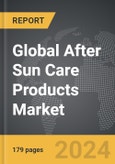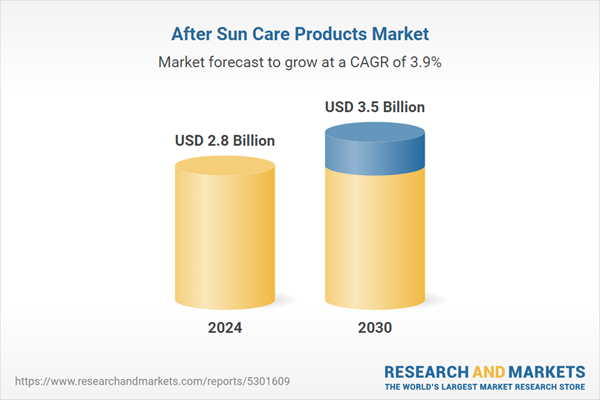The global market for After Sun Care Products was valued at US$2.8 Billion in 2024 and is projected to reach US$3.5 Billion by 2030, growing at a CAGR of 3.9% from 2024 to 2030. This comprehensive report provides an in-depth analysis of market trends, drivers, and forecasts, helping you make informed business decisions. The report includes the most recent global tariff developments and how they impact the After Sun Care Products market.
Segments: Type (Lotion, Cream, Gel, Powder, Spray, Other Types).
Geographic Regions/Countries: World; United States; Canada; Japan; China; Europe (France; Germany; Italy; United Kingdom; Spain; Russia; and Rest of Europe); Asia-Pacific (Australia; India; South Korea; and Rest of Asia-Pacific); Latin America (Argentina; Brazil; Mexico; and Rest of Latin America); Middle East (Iran; Israel; Saudi Arabia; United Arab Emirates; and Rest of Middle East); and Africa.
The analysts continuously track trade developments worldwide, drawing insights from leading global economists and over 200 industry and policy institutions, including think tanks, trade organizations, and national economic advisory bodies. This intelligence is integrated into forecasting models to provide timely, data-driven analysis of emerging risks and opportunities.
Global After Sun Care Products Market - Key Trends and Drivers Summarized
Why Are After Sun Care Products Essential for Skin Health?
After sun care products have become a vital component of skincare routines, particularly as awareness about the damaging effects of sun exposure continues to rise. Prolonged exposure to ultraviolet (UV) radiation can lead to a host of skin issues, including sunburn, premature aging, dehydration, and even increased risk of skin cancer. While sunscreen is critical for protection before sun exposure, after sun care products are specifically designed to soothe, repair, and hydrate the skin after it has been exposed to harmful UV rays. These products contain ingredients such as aloe vera, antioxidants, and hydrating agents like glycerin that work to calm inflammation, restore moisture, and repair damaged skin cells. They provide relief from the discomfort of sunburns, help to prevent peeling, and promote faster recovery of the skin’s natural barrier. As people become more conscious of the need for holistic sun care, after sun products are emerging as an indispensable part of comprehensive sun protection regimes, ensuring that the skin remains healthy and rejuvenated even after a day spent outdoors.How Do After Sun Care Products Differ from Regular Moisturizers?
Though after sun care products may seem similar to regular moisturizers, they serve very different purposes and are formulated to address specific skin needs following sun exposure. The primary focus of after sun care products is to soothe and repair the damage caused by UV radiation, while traditional moisturizers are generally designed to hydrate and nourish the skin on a daily basis. After sun products are often enriched with ingredients that specifically target inflammation, redness, and irritation, such as aloe vera, which is renowned for its cooling and anti-inflammatory properties. Additionally, many after sun care formulas contain antioxidants like vitamin E or green tea extract, which help neutralize free radicals generated by UV exposure, preventing further damage to the skin at the cellular level. Hydrating ingredients in after sun care products are typically more concentrated, as sun exposure often leads to significant moisture loss, resulting in dry, tight, or peeling skin. Furthermore, some products are infused with ingredients that aid in prolonging a tan, enhancing the skin’s glow, while simultaneously ensuring that it remains healthy and hydrated. In contrast, regular moisturizers, though beneficial for overall skin maintenance, do not necessarily provide the specialized care needed after sun exposure, making after sun care products a crucial addition to summer skincare routines.What Are the Key Ingredients in After Sun Care Products and Their Benefits?
After sun care products are formulated with a blend of specific ingredients that work synergistically to repair, soothe, and protect the skin after exposure to the sun. One of the most common and effective ingredients is aloe vera, a natural extract that provides an immediate cooling effect while reducing inflammation and promoting skin healing. Its high water content helps replenish lost moisture, making it ideal for sun-damaged skin. Another key ingredient frequently found in after sun products is glycerin, a powerful humectant that draws moisture into the skin, preventing it from becoming dry or peeling after sunburn. Antioxidants, such as vitamins E and C, are also crucial in after sun care formulas, as they help neutralize the free radicals produced by UV exposure, which can accelerate aging and lead to cellular damage. These antioxidants play a critical role in repairing and regenerating skin cells, thus preventing long-term damage such as wrinkles or hyperpigmentation. Additionally, many after sun care products contain botanical extracts like chamomile, calendula, or green tea, which offer anti-inflammatory and soothing benefits to alleviate the discomfort caused by sunburn. Some formulations may also include natural oils such as coconut oil or jojoba oil, which help to restore the lipid barrier of the skin, locking in hydration and preventing further moisture loss.What Factors Are Driving Growth in the After Sun Care Products Market?
The growth in the after sun care products market is driven by several factors, reflecting both increased awareness of sun safety and evolving consumer preferences for more effective and holistic skincare solutions. One of the primary drivers is the rising global incidence of skin conditions related to sun exposure, including sunburn, hyperpigmentation, and premature aging. As people become more conscious of the harmful effects of UV radiation, there is growing demand for products that not only prevent but also treat and repair sun damage. This shift in consumer behavior is further amplified by the rising popularity of outdoor activities and travel, particularly in tropical and sunny climates, which increases the need for effective after sun care solutions. Additionally, the trend toward natural and organic skincare products is influencing the after sun care market, as consumers seek products formulated with plant-based ingredients and free from harsh chemicals. This has led to an increase in the development of after sun products that feature organic and sustainable ingredients, appealing to environmentally conscious consumers. Moreover, advancements in skincare technology and research have resulted in more sophisticated formulations that not only soothe sunburn but also address long-term skin health by incorporating anti-aging and reparative ingredients such as antioxidants and peptides. The increased awareness about skin cancer prevention has also played a significant role in driving demand for after sun care products, as individuals seek comprehensive sun protection solutions that extend beyond sunscreen application. Finally, the growing influence of social media and beauty influencers has popularized after sun care products as part of a well-rounded skincare regimen, encouraging consumers to invest in post-sun treatments that help maintain their skin’s health and appearance. Together, these factors are propelling the after sun care market forward, with consumers prioritizing effective, natural, and innovative solutions for sun-damaged skin.Report Scope
The report analyzes the After Sun Care Products market, presented in terms of units. The analysis covers the key segments and geographic regions outlined below.Segments: Type (Lotion, Cream, Gel, Powder, Spray, Other Types).
Geographic Regions/Countries: World; United States; Canada; Japan; China; Europe (France; Germany; Italy; United Kingdom; Spain; Russia; and Rest of Europe); Asia-Pacific (Australia; India; South Korea; and Rest of Asia-Pacific); Latin America (Argentina; Brazil; Mexico; and Rest of Latin America); Middle East (Iran; Israel; Saudi Arabia; United Arab Emirates; and Rest of Middle East); and Africa.
Key Insights:
- Market Growth: Understand the significant growth trajectory of the Lotion segment, which is expected to reach US$1.0 Billion by 2030 with a CAGR of a 3.9%. The Cream segment is also set to grow at 3.9% CAGR over the analysis period.
- Regional Analysis: Gain insights into the U.S. market, valued at $741.8 Million in 2024, and China, forecasted to grow at an impressive 5.9% CAGR to reach $725.6 Million by 2030. Discover growth trends in other key regions, including Japan, Canada, Germany, and the Asia-Pacific.
Why You Should Buy This Report:
- Detailed Market Analysis: Access a thorough analysis of the Global After Sun Care Products Market, covering all major geographic regions and market segments.
- Competitive Insights: Get an overview of the competitive landscape, including the market presence of major players across different geographies.
- Future Trends and Drivers: Understand the key trends and drivers shaping the future of the Global After Sun Care Products Market.
- Actionable Insights: Benefit from actionable insights that can help you identify new revenue opportunities and make strategic business decisions.
Key Questions Answered:
- How is the Global After Sun Care Products Market expected to evolve by 2030?
- What are the main drivers and restraints affecting the market?
- Which market segments will grow the most over the forecast period?
- How will market shares for different regions and segments change by 2030?
- Who are the leading players in the market, and what are their prospects?
Report Features:
- Comprehensive Market Data: Independent analysis of annual sales and market forecasts in US$ Million from 2024 to 2030.
- In-Depth Regional Analysis: Detailed insights into key markets, including the U.S., China, Japan, Canada, Europe, Asia-Pacific, Latin America, Middle East, and Africa.
- Company Profiles: Coverage of players such as Avon Products, Inc., Beiersdorf AG, Bioderma Laboratories, Burt's Bees, Inc., Christian Dior SE and more.
- Complimentary Updates: Receive free report updates for one year to keep you informed of the latest market developments.
Some of the 213 companies featured in this After Sun Care Products market report include:
- Avon Products, Inc.
- Beiersdorf AG
- Bioderma Laboratories
- Burt's Bees, Inc.
- Christian Dior SE
- Clarins S.A
- Coty Inc.
- Estée Lauder Companies Inc. (The)
- Johnson & Johnson Services, Inc.
- Kao Corporation
- Lancaster Group
- L'Oréal S.A.
- Procter & Gamble Company (The)
- Revlon, Inc.
- Shiseido Company, Limited
- Unilever PLC
Tariff Impact Analysis: Key Insights for 2025
Global tariff negotiations across 180+ countries are reshaping supply chains, costs, and competitiveness. This report reflects the latest developments as of April 2025 and incorporates forward-looking insights into the market outlook.The analysts continuously track trade developments worldwide, drawing insights from leading global economists and over 200 industry and policy institutions, including think tanks, trade organizations, and national economic advisory bodies. This intelligence is integrated into forecasting models to provide timely, data-driven analysis of emerging risks and opportunities.
What’s Included in This Edition:
- Tariff-adjusted market forecasts by region and segment
- Analysis of cost and supply chain implications by sourcing and trade exposure
- Strategic insights into geographic shifts
Buyers receive a free July 2025 update with:
- Finalized tariff impacts and new trade agreement effects
- Updated projections reflecting global sourcing and cost shifts
- Expanded country-specific coverage across the industry
Table of Contents
I. METHODOLOGYII. EXECUTIVE SUMMARY2. FOCUS ON SELECT PLAYERSIII. MARKET ANALYSISSOUTH KOREAREST OF ASIA-PACIFICARGENTINABRAZILMEXICOREST OF LATIN AMERICAIRANISRAELSAUDI ARABIAUNITED ARAB EMIRATESREST OF MIDDLE EASTIV. COMPETITION
1. MARKET OVERVIEW
3. MARKET TRENDS & DRIVERS
4. GLOBAL MARKET PERSPECTIVE
UNITED STATES
CANADA
JAPAN
CHINA
EUROPE
FRANCE
GERMANY
ITALY
UNITED KINGDOM
SPAIN
RUSSIA
REST OF EUROPE
ASIA-PACIFIC
AUSTRALIA
INDIA
LATIN AMERICA
MIDDLE EAST
AFRICA
Companies Mentioned (Partial List)
A selection of companies mentioned in this report includes, but is not limited to:
- Avon Products, Inc.
- Beiersdorf AG
- Bioderma Laboratories
- Burt's Bees, Inc.
- Christian Dior SE
- Clarins S.A
- Coty Inc.
- Estée Lauder Companies Inc. (The)
- Johnson & Johnson Services, Inc.
- Kao Corporation
- Lancaster Group
- L'Oréal S.A.
- Procter & Gamble Company (The)
- Revlon, Inc.
- Shiseido Company, Limited
- Unilever PLC
Table Information
| Report Attribute | Details |
|---|---|
| No. of Pages | 179 |
| Published | April 2025 |
| Forecast Period | 2024 - 2030 |
| Estimated Market Value ( USD | $ 2.8 Billion |
| Forecasted Market Value ( USD | $ 3.5 Billion |
| Compound Annual Growth Rate | 3.9% |
| Regions Covered | Global |









